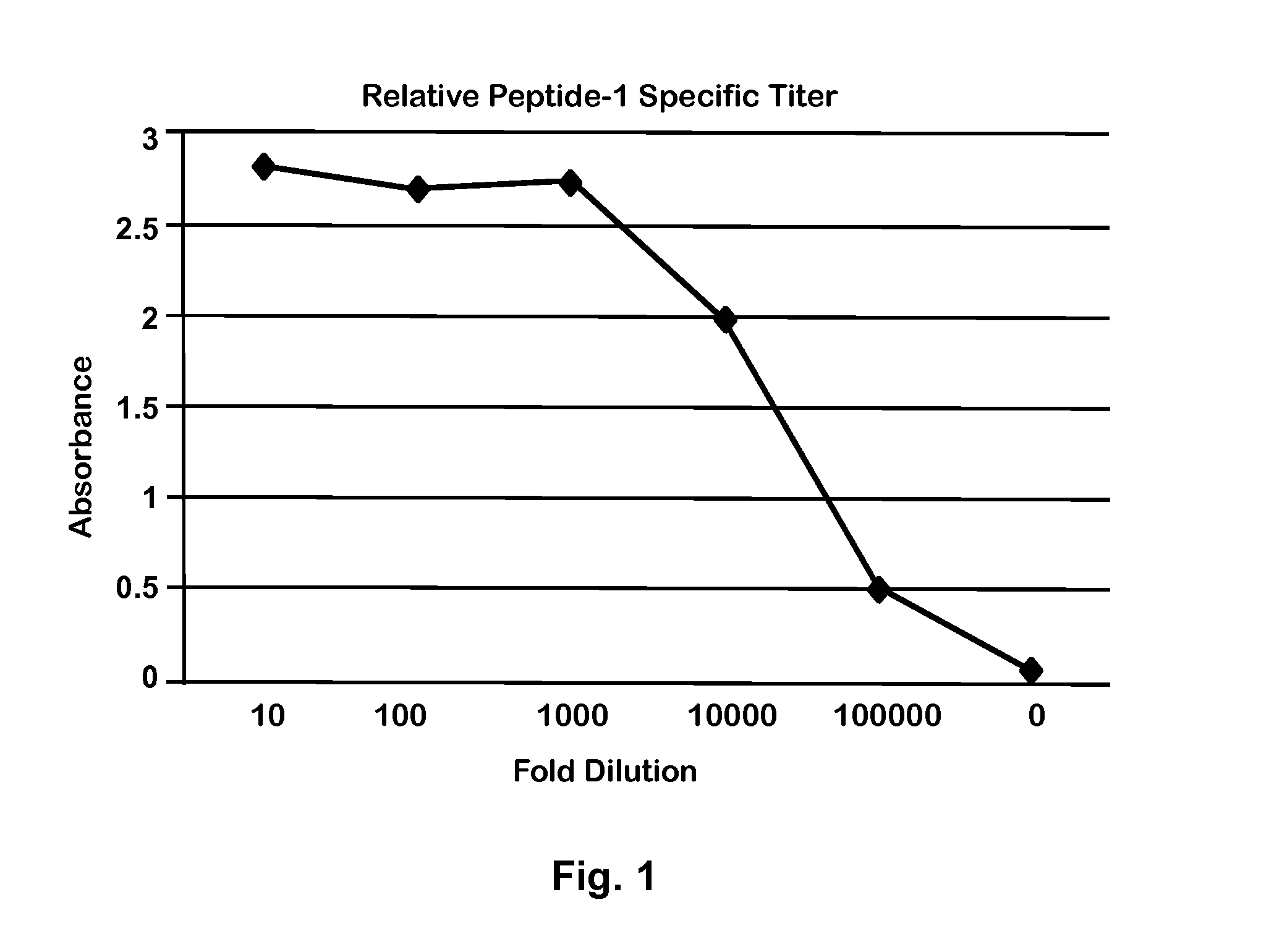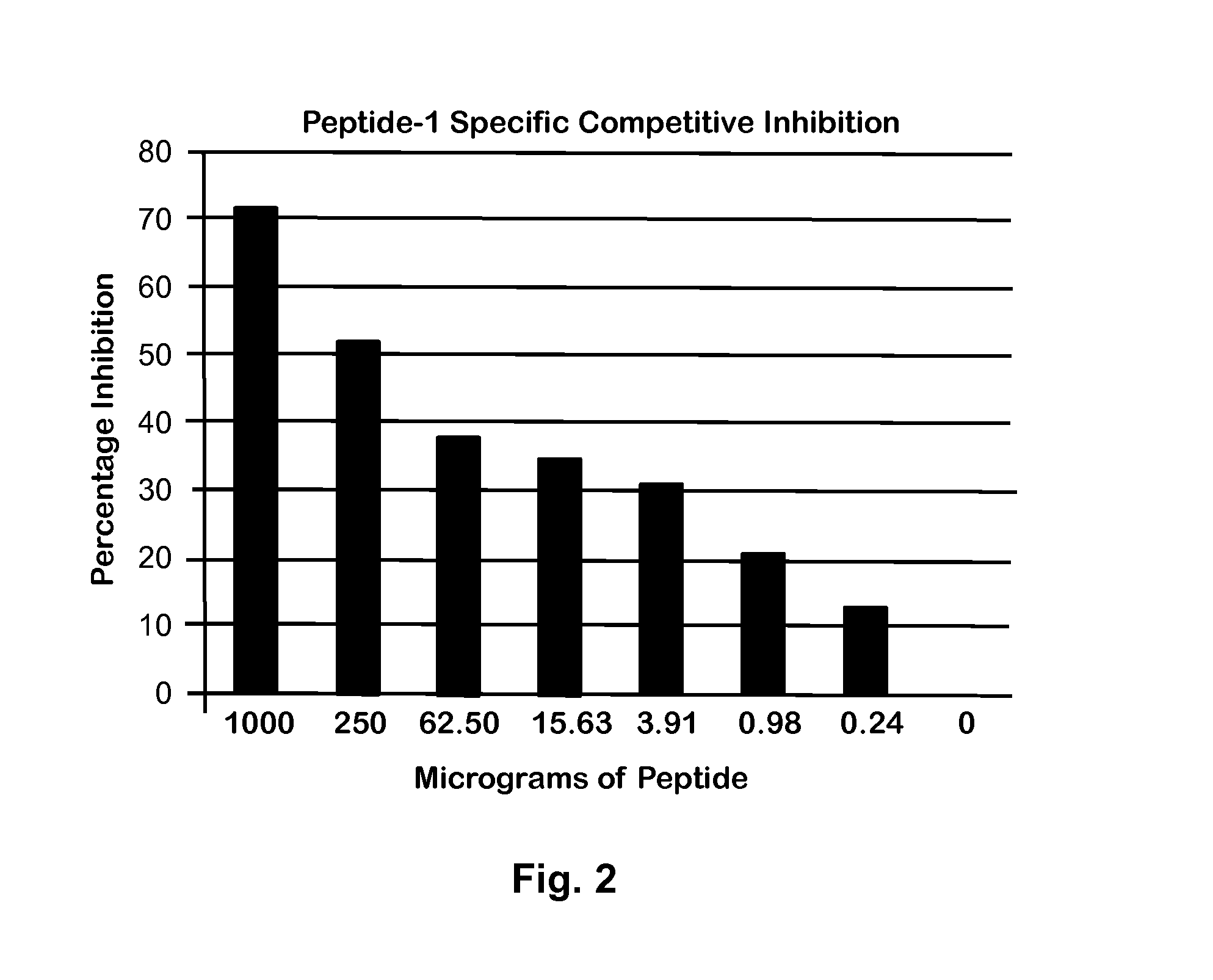Peptide for Protection of Allergic Respiratory Disorders
a technology of peptides and allergies, applied in the direction of peptides, immunoglobulins against animals/humans, drug compositions, etc., can solve the problems of high morbidity and human population threat, cumbersome therapeutic regimens, and accumulation of neutrophils in lung and bronchospasm, and achieve protection or alleviation of symptoms, validated antibody specificity, and high titers
- Summary
- Abstract
- Description
- Claims
- Application Information
AI Technical Summary
Benefits of technology
Problems solved by technology
Method used
Image
Examples
example 1
[0034]Development of CC10 Peptide Antibody
[0035]An isolated 21-amino acid peptide was designed and made based on the ‘C’ terminal 21 amino acid peptide of Equine CC10 protein (Accession no. NP—001075327.1) (“Peptide-1; SEQ ID NO:1; KNTKDSILKLMDKIAKSPLCA). The sequence of this peptide corresponds to amino acids 71-91 of equine CC10 and does not overlap with that of the peptide (amino acids 47-66) previously used to make rabbit antibodies (24). Peptide-1 was used to develop rabbit polyclonal antibodies. Briefly, Peptide-1 was conjugated to the carrier protein KLH (Keyhole Limpet Hemocyanin), and the conjugate used to immunize naïve rabbits to induce an immune response. Antibodies were purified from serum of immunized rabbits by established chromatographic techniques as described previously (21). The rabbit antibody was verified in an antibody capture endpoint Enzyme-Linked ImmunoSorbent Assay (ELISA) with Peptide-1 as the capture antigen and peroxidase conjugated goat anti-rabbit IgG ...
example 2
[0036]Development of a Competitive Inhibition ELISA Assay
[0037]Based on the results in FIG. 1, a 1:5000 dilution of this antibody was used for further CC10 detection in a competitive ELISA. To validate the competitive inhibition assay, a series of Peptide-1 dilutions starting at 1000 μg / mL was prepared. From each dilution, 50 μL was mixed with 50 μL of a solution of 1:5000 diluted rabbit polyclonal antibody. This mixture was incubated for 30 min, and then used in ELISA with a Peptide-1 coated plate as described previously (9). As shown in FIG. 2, the inhibition of antibody binding to peptide coated plated was dependent on Peptide-1 concentration.
example 3
[0038]Determination of CC10 Specific IgG Titer—Elevated CC10 IgG Titer
[0039]The competitive ELISA system as described above (Example 2) was used to measure relative levels of CC10 in the serum of 5 healthy and 5 RAO horses. Briefly, 10 μL of serum from each horse was mixed with 50 μL of a 1:5000 diluted rabbit antibody to Peptide-1 and incubated at 37° C. for 30 min. This serum-antibody mixture was then added to wells on ELISA plate pre-coated with Peptide-1 and blocked with 2% milk powder proteins (Carnation Milk, Nestle). The amount of free peptide specific rabbit antibody available to bind to Peptide-1 coated on the plate varied, depending on the amount of native CC10 present in the serum sample,. Plates were washed, and the amount of rabbit IgG bound to the plate was measured using Goat anti-rabbit IgG-HRP (Jackson ImmunoResearch Laboratories, Inc.). Surprisingly, some of the healthy horses had a significantly high titer than the control samples which had only rabbit peptide IgG...
PUM
| Property | Measurement | Unit |
|---|---|---|
| body weights | aaaaa | aaaaa |
| total volume | aaaaa | aaaaa |
| time | aaaaa | aaaaa |
Abstract
Description
Claims
Application Information
 Login to View More
Login to View More - R&D
- Intellectual Property
- Life Sciences
- Materials
- Tech Scout
- Unparalleled Data Quality
- Higher Quality Content
- 60% Fewer Hallucinations
Browse by: Latest US Patents, China's latest patents, Technical Efficacy Thesaurus, Application Domain, Technology Topic, Popular Technical Reports.
© 2025 PatSnap. All rights reserved.Legal|Privacy policy|Modern Slavery Act Transparency Statement|Sitemap|About US| Contact US: help@patsnap.com



